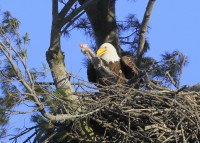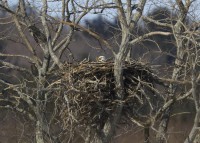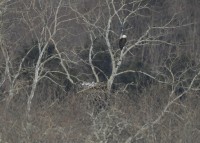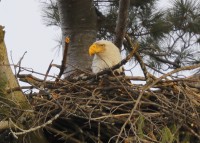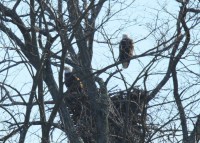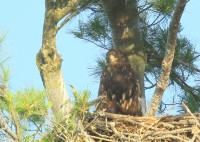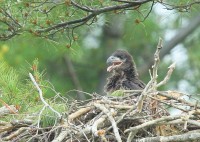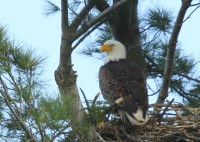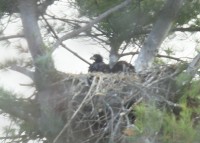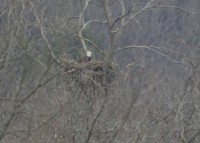 This new Bald Eagle nest may well be used for the first time in 2017. The nest was completed in the fall of 2015 and the Eagle pair spent a great deal of time around the nest in the spring of 2016. But it appears that no eggs were ever laid. This “playing house” is not unusual among a newly formed pair of Eagles.
This new Bald Eagle nest may well be used for the first time in 2017. The nest was completed in the fall of 2015 and the Eagle pair spent a great deal of time around the nest in the spring of 2016. But it appears that no eggs were ever laid. This “playing house” is not unusual among a newly formed pair of Eagles.
It has been stated for many years that a Bald Eagle pair will mate for life, but if one partner dies, or disappears, the other will if lucky find another mate. A newly bonded pair may work several years on a nest before actually breeding. They may desert one nest site and start again somewhere else, usually within 1/2 mile. In Eastern Massachusetts, bald eagles will begin to nest sometime in February or March. Each nesting pair will spend a great amount of time preparing the nest before any egg is laid. The successful nest is generally located in a large tree, within one mile from water, either a lake or river, where adequate food is available.
Bald eagle nests are generally found from (50 to 120 feet) above the ground, in a tall, sturdy tree. It takes at least two weeks for a pair of eagles to build their nest.
A typical bald eagle nest will range from 6-10 feet in diameter and about 6 to 10 feet high. The nest cavity, where the eggs are laid, will be about 12 to 16 inches in diameter and about 4 inches deep.
A pair of eagles, once established, may use the same nest several times over a period of years. Each year more materials are added to the nest, which increases the size of the nest each year that it is used. Nests weighing up to 2 tons have been found. Stay tuned!
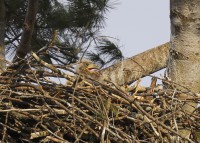 A late afternoon visit to Bald Eagle nest #1 in Essex county for nice looks at the young eagle nestling. Rough estimate that this young baby eagle is about 3-4 weeks old. No sign yet that there is another young bird in the nest. This was a moment when the adults were not in the nest and the the young nestling was up and about checking out the local surroundings!
A late afternoon visit to Bald Eagle nest #1 in Essex county for nice looks at the young eagle nestling. Rough estimate that this young baby eagle is about 3-4 weeks old. No sign yet that there is another young bird in the nest. This was a moment when the adults were not in the nest and the the young nestling was up and about checking out the local surroundings!